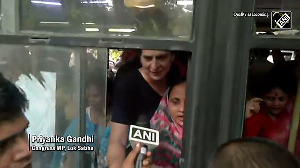Barring a few, notable exceptions, rural marketing in India is still about a van campaign, a badly-made commercial, a few painted walls and the occasional participation in village haats and melas.
But then, "rural" means different things to different people: from 500,000 people for consumer durables, to less than 50,000 for fast-moving consumer goods.
Still, it is heartening to note the increasing awareness of the importance of rural markets - or, at least, of companies wanting to move beyond urban boundaries.
According to estimates by the Rural Marketing Agencies Association of India, the total budget for rural marketing is only about Rs 500 crore (Rs 5 billion), compared to the over Rs 13,000 crore (Rs 130 billion) allotted to mass media.
This is grossly inadequate to cover the huge potential for different products in rural markets. Of course, clients' reluctance to spend big money for bigger results in rural markets is because there are no standard performance yardsticks for judging the efficacy of the rural marketing efforts.
The TRPs and NRS/IRS data help you determine the efficacy of TV and press marketing. But there is no study to tell you what is the ideal cost per contact or what is the ideal number of eyeballs or footfalls for different rural activities.
But only consider the huge successes of some regional brands, especially in the FMCG sector, which are giving the multinationals a run for their money.
Companies like Cavin Kare (Chik Shampoo, Meera Herbal Powder, Fairever Cream and so on), Anchor (100 per cent vegetarian toothpaste), Ghadi detergent powder and Power soap are proof that regional brands can become brands to reckon with. And don't forget Nirma, the most enduring example of a brand that began as a regional player and is now a giant.
What did these products do that was so different? Most of them identified a segment that was vacant in terms of product and area of operation. They all started in small, concentrated markets, appealing to the local ethos and aspirations of the targeted area.
Their communication, be it a simple radio spot or a wall painting or a theatre film, touched a chord in the target audience. And, most importantly, their policies were flexible and they could adopt to fast changing marketing situations. What should companies do to step up their payback from rural marketing efforts? Here are some steps that should help.
People power
Total commitment from top leadership, keeping in mind that rural marketing is a long-term relationship, is imperative - the successes of Hindustan Lever and ITC are proof of this statement. But even more important is the need for a dedicated task force.
Rural marketing efforts need special mindsets, which many of the urban-oriented management graduates who are at the helm of affairs at most organisations do not possess.
A separate marketing and sales vertical headed by people with passion and commitment to rural marketing and supported by a field team that can face the rough and tough of the vast country-side with courage and conviction is a must.
The best bet is to recruit students from specialised institutes such as the Indian Institute of Rural Management, or at least, management graduates who have studied the subject as an elective.
Many of these are students from small towns, people with fire in their bellies who want to prove themselves in big companies and have no issues about working in smaller markets. Pay them well - remember, you pay peanuts, you get only monkeys - and discuss the path their careers are likely to take in the organisation. And send them out in the field only after thorough training.
Ensure the consistency of the team involved in any project, until the completion of a specific task. Recently, we were involved with two big clients. In both cases, the teams that briefed us in the initial stages and participated enthusiastically in the campaign, were shifted out midway, in keeping with their companies' policy of shifting and promoting people.
The teams that succeeded felt no ownership of the campaigns they had not initiated. What started as a great rural marketing initiative has been relegated to the dustbin... the fate of many rural marketing initiatives in the country.
Goals are good
Early on in the campaign, define your objective: is it a tactical effort to achieve increased sales in specific areas during a specific time, or do you want to build a strong equity for your brand in rural India?
Our experience with FMCG companies is that they are more interested in the first choice. Most of them have previously appointed vendors who implement the company's ideas blindly, be they van campaigns or below-the-line activities.
There is very little effort to tailor whatever communication is made in such efforts, to suit the local audience or fit it with the overall campaign efforts in the mass media.
This invariably leads to less than satisfactory results in terms of awareness of the brands and long-term impact of the efforts in the targeted markets. If you are interested in the second alternative, a comprehensive brand building strategy in rural India, with both short term and long term goals, is a must.
Know your customers
A good place to begin is studying the mindset of your customers, so you can create a customised plan of action. All too often, clients insist their knowledge of their customers (based on studies of urban India) is enough on which to base an action plan. Our experience shows that the attitudes, aspirations and fears of rural customers, with regard to products and brands, is very different from their urban counterparts.
Research can give you invaluable ideas for new product development as well as new methods of reaching your target audience. The refrigerator with standby power for 12 hours, pressure cookers with two handles and a radio with key-winding mechanism are all the result of research.
More and more companies turn to the local haats to sell their products. While haats offer opportunities to target consumers from several villages at one place, and to that extent make your effort cost-effective, ensure that the people who patronise these haats are the kind who will buy your brand.
For instance, we recently conducted a survey among some haats in Tamil Nadu, with some interesting results. The haats were popular with the poorest agricultural labourers who consciously buy the duplicate, spurious products that are sold in these bazaars, since they can't afford the real thing. It is estimated that FMCG companies lost more than Rs 10,000 crore (Rs 100 billion) to spurious products, mostly sold through such local haats and bazaars.
Ensure availability
Most anecdotes about rural marketing centre on the distribution aspect - the humongous task of physically reaching your product to over 600,000 villages, most of them without motorable roads. But it's not really as nightmarish as it is made out to be, at least keeping in mind the present goals of marketing companies in rural India.
We've all heard about the shampoo sachets that are available in even the smallest villages. How does that happen? It's a direct result of rising aspirations, fuelled by television commercials. The consumer demands the product from the local shopkeeper, who then buys the products from the nearest feeder markets.
Which means if you can ensure distribution to the feeder markets in towns or villages with populations of 10-15,000, you've already taken the first step towards reaching your target customer.
Studies also indicate that rural consumers prefer to shop for durables such as televisions, automobiles and appliances in the nearest big town or city. So, if your products are in towns with populations of 50,000, you're closer to the rural consumer than you would have thought.
R V Rajan is chairman and managing director, Anugrah Madison Advertising, and president, Rural Marketing Agencies Association of India.





